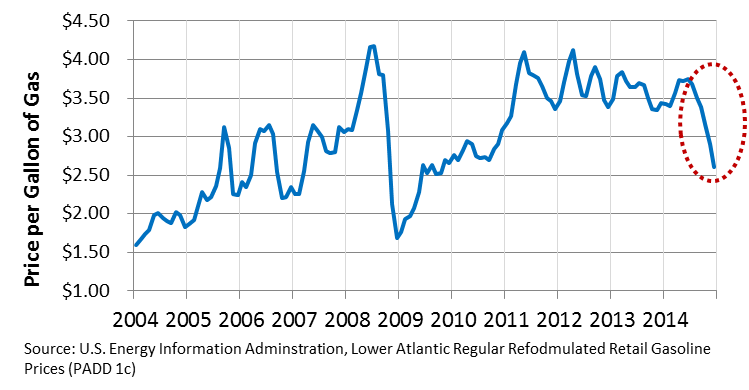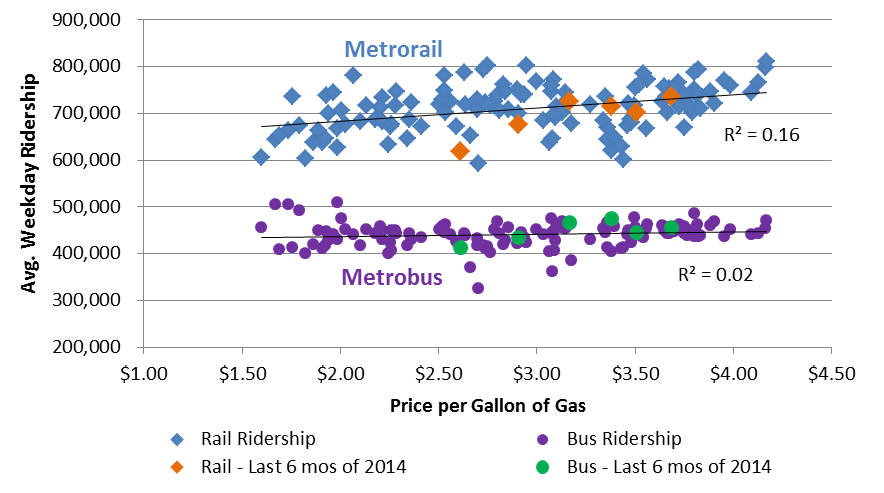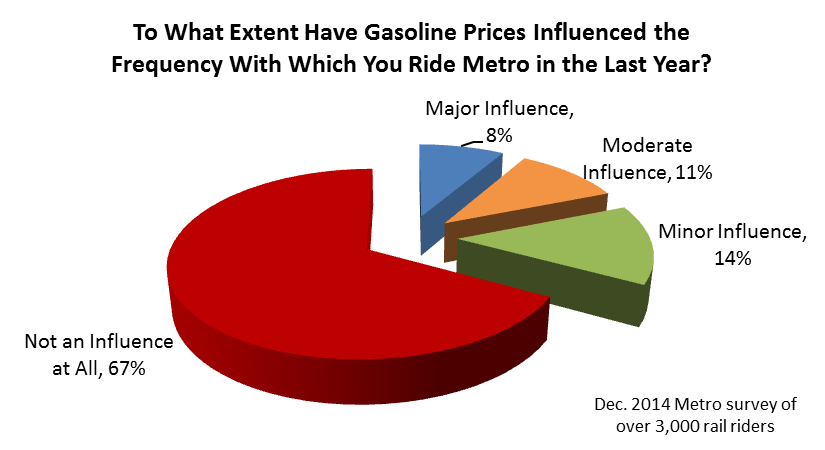Are Low Gas Prices Impacting Ridership at Metro?
As gasoline prices drop and commuters feel less pain at the pump, do they drive more and take Metro less? The short answer is maybe, but not much.
In recent months, gasoline prices in the Washington region have dropped by over a dollar per gallon, to a near-record low of around $2.50 per gallon. Here’s how gas prices have changed in the last 11 years (unadjusted for inflation):
Below is a simple scatter plot comparing those prices to bus and rail ridership to gasoline prices, by month, for the last 11 years. It shows that gas prices have a very small, nearly negligible, effect on Metro ridership. The relationship is essentially zero for Metrobus, and barely detectable on Metrorail as a whole, as pictured below. The link is best with off-peak rail ridership (R2 = 0.24) compared to peak ridership (R2 = 0.09), suggesting that off-peak Metrorail riders are most sensitive to gas prices. (Not pictured.)
The last 6 months of 2014 are highlighted a different color, showing that the last few months – despite the drop in price of over $1.00 per gallon – have behaved little different than the last decade.
Other factors like tourism, the economy, seasonality, the maximum amount of the transit benefit and bus service changes have a much more significant impact on ridership than gas prices. In fact, in prior statistical work, we have explained 91-96% of past variability in ridership using factors other than gas prices.
Metro’s 2012 short-term ridership forecasting models suggest that lower gas prices are mildly linked to bus and peak Metrorail ridership, but that the effect is only visible a few months later, and that the elasticity “appears to be in the low end of the range… reported in the literature.” Interestingly, this work did not detect a link with off-peak rail ridership, including weekends. Once we account for other reasons for ridership changes, gas prices are not a significant factor.
Finally, our riders also report that gas prices have some impact, but not much. A survey of over 3,000 Metrorail riders conducted by our Customer Research team last month shows that two-thirds of riders say gas prices have “no influence” on their decision to ride, and less than 20% say the influence is “moderate” or “major.”
2/12/2015 Update: The results of this survey hold relatively constant by jurisdiction, as well. Riders originating further out in the suburbs, particularly in Prince George’s County, are a bit more likely to care about gas prices, but not by much. (Thanks to a commenter below for the idea for this cross-tab)
We’ll be keeping an eye on gas prices in the future, but for now, their connection to ridership appears fairly thin. What do you think – has the price of gasoline influenced your decision to ride Metro less or more? Bus, rail, both, or neither?






Justin –
Looking at the orange diamonds on the scatter chart for Metrorail ridership during the last six months of 2014, it appears that, given falling gas prices during the period, these diamonds represent the months of July through December in chronological order from right to left. If that is indeed the case (a reasonably logical assumption IMHO), I believe you are much too sanguine about the impact of lower gas prices on Metrorail ridership because it looks like Metrorail has truly hemorrhaged riders from October to December, dropping by over 100,000 average weekday riders in just two months and making December 2014 the fifth-worst ridership month over the entire 11-year period represented on the chart. This occurred with about a 50-60¢ drop in the price of a gallon of gas during those two months. And since a similar-sized decline in the price of a gallon of gas occurred in January, I am concerned about the likelihood of a further significant reduction in the average weekday ridership on Metrorail last month (without even taking into account the potentially negative affect that recent operational and reliability issues have had on Metrorail ridership levels). Also, I would think that WMATA knows the Metrorail average weekday ridership for January 2015 by now (today is February 11th), and it would provide a valuable additional data point in your analysis to see if the recent downward ridership trend has continued. This would show whether the recent trend in Metrorail ridership since July 2014 is more closely correlated to the change in gas prices than the 11-year R-squared figure would seem to indicate.
Regarding the pie chart analyzing the influence of the changed gas prices on Metro ridership, it would be interesting to know the jurisdictions in which your survey respondents lived (assuming that the survey even asked that question). If, as I suspect, the majority of those claiming that the change in gas prices had no influence on their Metro ridership lived in DC or Arlington (where I believe car ownership per household is less than in the more distant suburbs), the detrimental impact on Metro’s revenues would be greater than the impact on its ridership, given the generally longer distances traveled (and thus higher fares paid) by Metro’s riders living in the more distant jurisdictions.
I would be very interested in your thoughts on my comments above.
@Mike in Tysons Good and thoughtful observations, thanks. You’ve give me some good stuff to chew on. Ridership certainly did decline in the last 6 months of 2014 (from 747K to about 640K in December, avg. weekday), but this decline follows a normal seasonal trend that ridership peaks in the summer and bottoms out in winter. So it’s not quite accurate to attribute the decline entirely to gas prices. You can see this trend clearly in our visualization of the past 11 years of ridership . One way I could correct for this is to seasonally-adjust the monthly figures.
As for January 2015, it looks like we’re coming in around 645K, which is basically on par with, or even a little above, January 2014 (depends on how you treat the snow days in 2014).
Your idea about jurisdiction in the survey is a good one; I may be able to cross-tab it with the the locations of primary entry station.
I agree with this analysis – gas prices don’t have a huge impact on ridership. There are some exceptions – big spikes in prices can lead to people trying transit and sticking with it if they like it. But I don’t think slowly dropping gas prices lead to people abandoning transit for their cars.
Check out a comparison of the delta of both of these values – i.e. what % is ridership up/down compared to same month last year vs. the same for gas price. There is basically no correlation.
I think in just comparing gas price and ridership totals, you get a lot of confounding factors – gas prices and transit ridership both tracked with employment and gdp through the recession – a steep climb, followed by a steep drop, followed by a slow recovery.
@Mike in Tysons
I’ve updated the post to include a cross-tab of the survey question by jurisdiction of home station. What do you think?
At Rail~Volution 2009 in Boston, Peter Rogoff, head of the Federal Transit Administration, said that transit ridership stayed high when gas prices dropped from $4 a gallon. He thought that a lot of families had jettisoned a car and didn’t run out and buy another one just because gas was cheaper but instead stayed with transit.
My recollection from the spike in gas prices in 2008 is that they had a strong effect on ridership on MTA commuters buses. You’d expect the effect to be greater there. Looking at the same correlations for MTA, PRTC, Loudoun Transit would be a useful point of comparison. It might help extrapolate down to the WMATA effects which would be more buried in the noise.
I wouldn’t expect gas to be a significant factor as daily gas consumption between the most distant metro rail stop and downtown is negligible compared to a daily $15-20 parking garage fee like you will find in many places downtown.
I liked that visualization of ridership posted by Justin in the comments above. While ridership peaks in the summer, it appears August has significantly less ridership than July. From a weather standpoint, July and August are no different. In the school calendar, July and August are similar.
It would be a big undertaking, but I would like to see the impact on ridership when Congress is in session versus when it is not in session. I always feel the metro is less crowded when Congress is not in session and the 11-year vizualization lends to my theory for the month of August. The impact would surely be hugely exaggerated if the analysis also isolated riders using Capital South and Union Station Metro stations.